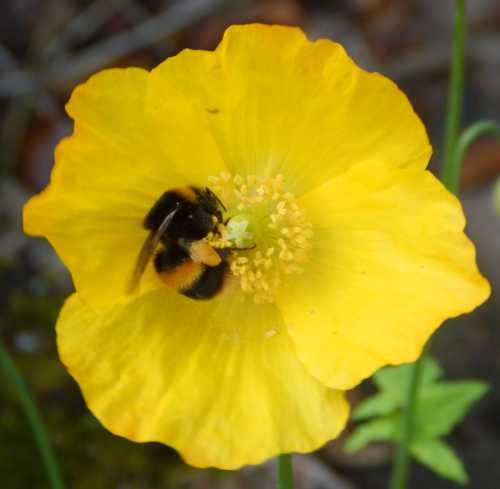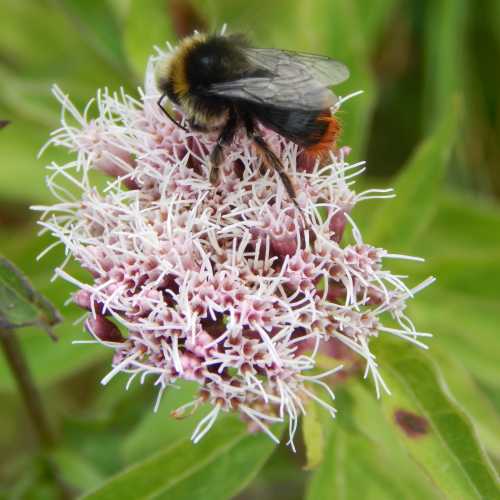Bee Nest Removal And Bumble Bee Nests
Updated: November 2023
Relocation of bumble bee nests needs to be undertaken carefully and safely, preferably to a spot where the bees will also stand the best chance of survival. Whilst steps are outlined below, in truth it is rarely necessary to remove or relocate a bumble bee nest.
Before attempting to remove a bumble bee nest: 7 considerations
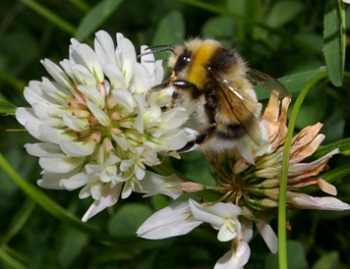 White-tailed bumble bee (male) on clover.
White-tailed bumble bee (male) on clover.- Bumble bees are not aggressive - they do not sting unprovoked, nor do they swarm. It is perfectly possible to go for a walk in the park without being stung by bees. Bees mostly go about their activities unnoticed and can be left alone. The 'malicious' bumble bee simply doesn't exist.
- The nest will no longer be active by the end of the summer (mid-Autumn latest), due to the life cycle of bumble bee colonies.
- Unlike honey bee colonies, bumble bee colonies are quite small: usually 100 - 250 bees, sometimes as few as 40 -50, not thousands. To read more about this, see: How many bumble bees in a colony?
- A colony of bumble bees can only be deemed successful if new queens are reared toward the end of the season. The new queens mate and feed, and then hibernate. The rest of the colony will die.
- If a colony is hampered before queens have had chance to emerge, a whole generation of bumble bees is destroyed.
- Survival of colonies can be a challenge, especially for some species. For example, in one study of 80 nests of Bombus pascuorum, only 23 produced new queens, and a further 9 produced only males1.
- Although I am providing guidance about how to move a bumble bee nest, please note, moving one is not always successful - especially if you have not had practice!
When people are aware of these factors coupled with the challenges faced by bees, most find they can live with the nest temporarily.
Some simple precautions, such as leaving the nest alone, and keeping children and dogs away from the nest, are usually sufficient.
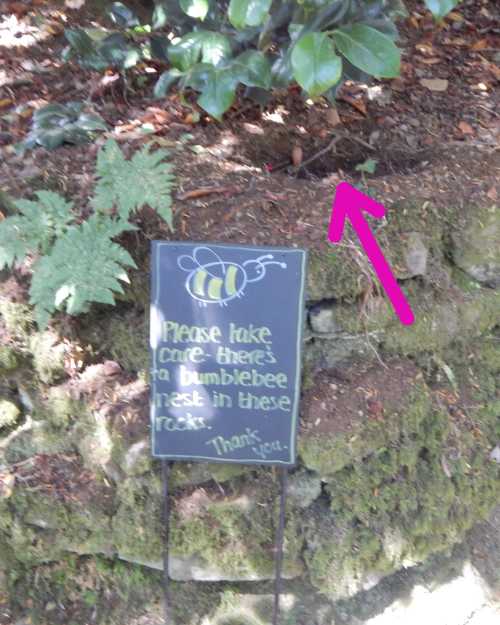 Some simple precautions, such as leaving the nest alone, and keeping children and dogs away from the nest, are usually sufficient.
Some simple precautions, such as leaving the nest alone, and keeping children and dogs away from the nest, are usually sufficient.
Is it a bumble bee nest?
Bumble bee nests, depending on the species, vary greatly. Some species like to make their nests in tussocks of grass or in abandoned rodent holes.
However, due to habitat destruction, especially the removal of hedgerows, many bumble bees are having to compromise, and a colony may even inhabit a compost heap, a bird box, a gap around a fascia board, an old upturned plant pot, or a space under the garden shed - or some places that humans would consider to be 'inconvenient'.
The queen will establish the nest on her own, and the workers only emerge from late spring and through the summer - see Bumble Bee Life Cycle.
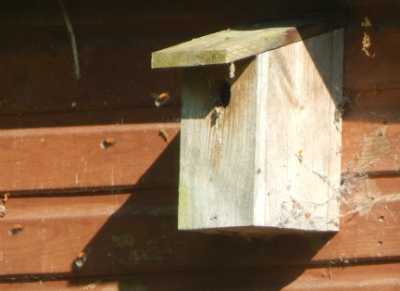 A colony of bumble bees has established itself in this bird box, but the nest will no longer be active in a few weeks.
A colony of bumble bees has established itself in this bird box, but the nest will no longer be active in a few weeks.If you see a number of similar fluffy bees entering and leaving the nest, it’s likely to be bumble bees.
4 Actions you could take before attempting to move a bumble bee nest
- A temporary barrier of plants or even a wind break, may act as a screen in the short term, to encourage bees to fly in a certain direction. It is better to put the screen in place at night when members of the colony are not actively flying about.
- Instead of moving the nest, why not consider participating in a bumble bee nest survey? Contact a relevant conservation body for guidance.
- If you are worried about children being stung, remember that children cannot be protected forever from absolutely everything. I was stung as a child at about 4 years old, and it was explained to me that the sting was an accident, and that bees are important. Now here I am with my website about bees! If children go for a walk in the park it is equally possible they'll be stung or bitten by a fly.
What you can do is apply insect repellent to your child's skin.
Whilst allergies to sting reactions are a concern, life-threatening allergies are rare. Know the symptoms, then if they are stung you'll be able to take immediate action. - With adults, unless an adult has a severe allergy, I have far less concern. Bees are very important, and an adult, even if stung, is able to cope with it.
If, having read the information above, you have decided not to disturb the bees, then on behalf of bees, I thank you sincerely!
6 Steps for moving a bumble bee nest
In the process of removal, please do your best to keep the nest intact, and avoid tipping.
1. First prepare an alternative nest site. A large wooden box, or very large, sturdy ceramic plant pot, would be ideal. It will need a covering to keep the rain out, yet it will also need space for the bees to fly in and out. Place some dry moss, grass and leaves (free of pesticides and weed killers) into the box.
2. Locate an
alternative spot for the nest. If you have a suitable, alternative place in your garden where you would be happy for the bees to rear the colony, you have the possibility to ensure the site is prepared first. If not, ideally, the location needs to be 2 miles away
to prevent confusion, and worker bees attempting to return to the
original nest site.
Perhaps you have a relative or friend who would
happily allow the bumble bees to live in their garden? Try to ensure
they do not use pesticides.
Alternatively, contact a local wildlife organization to see whether they have any appropriate suggestions about where the nest could be moved to.
The bumble bees' new home needs to be in a sheltered spot – perhaps a space under the garden shed, or a spot among some thorny brambles is possible? They also need plenty of flower material for collecting nectar and pollen.
3. Wait until the evening, until it is dark. Wear gloves and protective clothing. Bumble bees rarely sting, but moving the nest could cause them to feel threatened. Wear sturdy clothing strong enough to protect you from stings.
4. Have a box or your replacement nest box at the ready. Now carefully, calmly, and very, very gently, use a spade or shovel to lift up the nest. And place it in the box.
5. IMPORTANT! Do not tip the nest! Keep it upright and level, otherwise their nectar pots may spill – these are vital resources for the bees! Be gentle so the pots do not get damaged.
6. Take the bees to their new location, and gently place them there. Hopefully, they will take to their new place, and will thrive.
Dealing with bumble bee nests in specific scenarios
Over the years I have provided advice for a number of situations. You may find one or two of these pages relevant:
- Bumble bee nest in roof
- Bumble bee nest by the door
- Bumble bee nest in a compost heap or bin
- Bumble bee nest in the attic or loft
- Bumble bee nest in the bird box
Miscellaneous Concerns:
Engaging the assistance of a beekeeper to remove a nest
If you are concerned
about removing a bumble bee nest, by all means you could try calling a
beekeeper - some are happy to help.
However, bumble bee nests are very different from those of honey bees. There is no reason for anyone to expect a beekeeper to remove a bumble bee nest, and they may (understandably) be reluctant to attempt it. They may or may not require you to cover their expenses.
If you really cannot wait for the nest to be moved, and you cannot do it yourself, you could also consider calling a wildlife conservation organisation.
If they are a charity, be prepared to make a reasonable donation to cover their expenses. (Remember, they have to find the cost of salaries, fuel and any other expenses). But again, many organisations may be reluctant to remove bumble bee nests, or they may simply not have the resources.
Should you call in pest control or the council to remove a bumble bee nest?
I have come across many pest control companies who will not remove bumble bee nests, and they try to dissuade potential customers from taking this action. I applaud this stance.
I have also come across a few who will attempt to relocate the nest. Certainly, the British Association of Pest Controllers takes a dim view of removing bumble bee nests these days, and have produced a leaflet explaining why they refuse to remove the nest: We're Leaving You Bee.
I applaud this ethical stance.
However, some may prefer speed over caution, and may spray the nest with poison, killing the whole bumble bee colony.
Whatever their methods, you should check first, and remember, you'll still have to pay!
A similar scenario applies to your local council. Some will not remove bumble bee nests. If they do, they may charge you. Do find out first how they would deal with the
nest.
Resources
1. Goulson, D. 2010. Bumblebees, behavior and ecology. Oxford Univ. Press, Oxford, U.K, pg 146.
If you found this page helpful or interesting, I'd really be grateful if you would share it with others - if not this page, perhaps another, such as Gardening For Bees.
Thank you so much :) .
